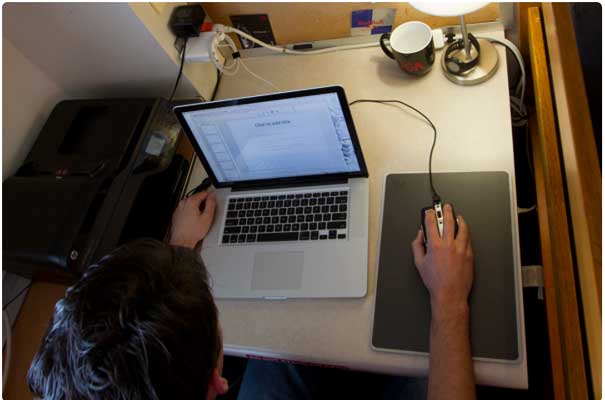Home office improvements for the Bulldog on a budget
It’s something I never thought I’d say, but after the first few months of working from home, the words came easily: man, do I miss my office.
A standing desk that gracefully ascends with the touch of a button; dual monitors bathing me in the light of productivity; drawers and cabinets sliding, opening, closing with a swift, silent efficiency: In comparison to my cobbled together home office, my DARCOMM office became an office nirvana.
So, after making that admission—and marching one step closer to being the working stiff I swore I’d never become—I started doing some homework. And what I found is that you can equip your home office with many of the creature comforts found in the “office office” on the cheap.
Standing Desk
Obviously, the convenience of a standing desk that raises or lowers automatically is hard to beat. But those sorts of desks can become wildly expensive, and oftentimes, there’s just not room in the house for a whole new desk.
My solution was the Levit8, a flat, folding platform that turns your regular desk into a standing desk in just a few seconds. It’s a little weird at first, figuring out how to fold this origami-based thing so that it will hold your computer. But once you’ve got it, it’s a breeze to elevate your work, and once you’re done with it, it folds down flat, so it’s easy to put away and declutter your work space.
Multiple Monitors
You may already have what you need for this in your home. The computer you use may already have an HDMI port (if it doesn’t, adapters can be found for very cheap—just make sure you get the right adapter for your computer), and if it does, you can connect it to most modern TVs via an HDMI cable (also cheap if you don’t have an extra at home) to turn your TV into an extra monitor. If you have a small TV somewhere, you might consider moving that into your workspace for this reason.
If you’d rather not have cables strung across your home office, depending on your device, you may be able to wirelessly use your TV (or another device) as a second display. Apple TV allows you to use AirPlay like this, and certain types of iPads can be used as a second display through the Sidecar feature. Chromecasts also allow you to use a connected TV as a second display.
Additional Storage
If you’re like me, you’re working from home in a space that wasn’t really designed to be a full-time, every-day home office. In my case, this means that there’s not a ton of space for me to put various devices, papers, mugs/bottles, and all the ephemera that collects in my workspace. One of the easiest ways to gain a little extra space is to go vertical by using risers on your desk.
I grabbed a two-pack for relatively cheap, and this allowed me to make use of much more space on my desk while still keeping things looking tidy. And speaking of keeping things tidy…
Paper on walls, desk, monitor, cabinets, keyboard, you get the idea
At the office, I leave myself a lot of notes, I take a lot of notes, and I make a lot of to-do lists. This is fine in the office, where I can keep things pasted all over creation and think nothing of it and once I’m done with a list or a note, I can just place it in the trash, secure in the knowledge that someone will be along each day to dispose of it.
Now that my job and living space are one-in-the-same, however—and because that space is shared by a certain someone with a vicious loathing of clutter—things are different. All those notes pile up quickly, as does the trash, and suddenly my desk is bristling with loose scraps of paper (and you can guess who has to take the trash out).
But I found a solution! A whiteboard-like surface roughly the size of a keyboard that comfortably fits on my desk. I jot down my notes, leave my to-dos, and once they’re done, they’re erased, leaving nothing behind.
These are a few of the things currently improving my workspace. What about you? Chime in on Teams with your best affordable home office improvement!




 Tim Bennett for Unsplash
Tim Bennett for Unsplash